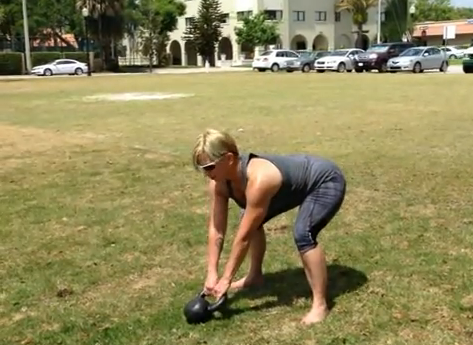It’s spring, the weather is warming up, the flowers are blooming and the sun is shining.
If you’ve been hibernating all winter and your workouts have gotten dull, now is the time to breathe new life into those workouts by taking your Kettlebells outside for some fun in the sun.
The possibilities for outdoor workouts are endless. I’ve been outside with my clients for several weeks working on some fun variations for outdoor workouts. Obviously, you need to be in a large grassy area or you could be liable for destroying property and we certainly don’t want that.
The workouts I’ve included are just a few of the fun variations that you can use. Get creative!
To get a full body workout, I start with bent over rows and push-ups. You can either do them once at the start of the workout or you can have them do the rows and push ups each time they pick up the bell.
Depending on how far you want to go down the field, you can vary the reps. If I plan to go far, then I will do 1 rep of each, swing, squat, curl and press before I throw the bell. If you want you can have your clients do several reps of swings, squats, curls and presses before they throw the bell.
Another option is to add a rep of each for every time they pick up their bell.
This can also be a time to work on form. At the end of the video, I included a “stop and throw” swing. This requires a very powerful hip snap in order to heave the bell as far as you can.
Hopefully this will give you some fun ideas and motivation to get you outside and enjoy the spring time.
***
Laurel Blackburn is an RKC Team Leader and owner of Boot Camp Fitness and Training and Tallahassee Kettlebells. Look for Laurel at www.bootcampstogo.com or www.tallahasseekettlebells.com.
In her early fifties, she is out to prove that age is just a number. Her goal is to motivate and inspire people everywhere, both young and old that strength, flexibility and mobility can get better with age. Follow her adventures on her blog: www.SuperStrongNana.com.










